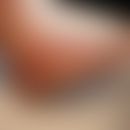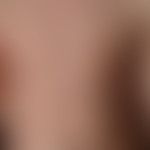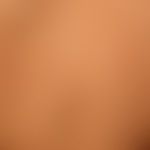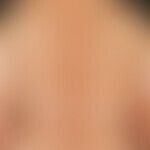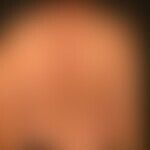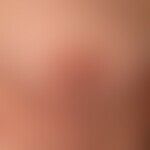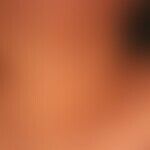Synonym(s)
HistoryThis section has been translated automatically.
DefinitionThis section has been translated automatically.
Group of hereditary, autosomal-dominantly inherited or spontaneously mutated neuroectodermal systemic diseases in which 8 types can currently be distinguished from a clinical and genetic point of view (see Table 1). The main symptom is neurofibroma.
You might also be interested in
ClassificationThis section has been translated automatically.
- Type I Peripheral neurofibromatosis, also known as classic or cutaneous NF, 85% of all cases. Autosomal dominant inherited defect of the NFI gene (neurofibromatosis-1 gene; gene locus: 17q11.2). It is characterized by cafe-au-lait spots and visible neurofibromas.
- Type II Central neurofibromatosis, uni- or bilateral acoustic neuromas (hearing loss often as first symptom at 20-30 years of age); cafe-au-lait spots only in about 50% of cases, no Lisch nodules. This form of neurofibromatosis is caused by an autosomal-dominantly inherited mutation of both alleles in the NFII gene (neurofibromatosis-2 gene; gene locus: 22q12.2) with consecutive disruption of the expression of the tumor suppressor protein Merlin (acronym for Moesin-Ezrin-Radixin like protein) also known as Schwannomin (see below).
- Type III Central-peripheral neurofibromatosis (palmo-plantar neurofibromatosis)
- Type IV Atypical neurofibromatosis (heterogeneous group). Autosomal-dominantly inherited inversions on gene locus 12q21-12q24.2.
- Type V Segmental neurofibromatosis, very rare, somatic mutation (see also association with Cobb syndrome)
- Type VI Familial intestinal neurofibromatosis (multiple café-au-lait spots without neurofibromas)
- Type VII Neurofibromatosis-pheochromocytoma-duodenal carcinoid system (NPDC)
- Type VIII neurofibromatosis-Noonan syndrome (syn. Watson syndrome), complex form of peripheral neurofibromatosis (NF type I) with the clinical phenotype of Noonan syndrome (short stature, ptosis, midface hypoplasia, pterygium colli, learning disability and muscle hypotonia). Autosomal dominant inherited defect of the NF1 gene (neurofibromatosis Noonan syndrome gene; gene locus: 17q11.2) with consecutive defect of neurofibromin (see NF1 gene below)
Occurrence/EpidemiologyThis section has been translated automatically.
Incidence: 30-40 patients/100,000 inhabitants; about 1 child affected/2,500-3,300 births. In about 50% of cases a new mutation is probable.
ManifestationThis section has been translated automatically.
Pigmentation spots appear from birth or in childhood, tumours mainly during puberty. Men are more frequently affected than women.
LocalizationThis section has been translated automatically.
ClinicThis section has been translated automatically.
The clinical picture varies according to the expression type of neurofibromatosis (see Tab).
- Pigmentary spots: café-au-lait spots, axillary freckling, patchy pigmentation of the oral mucosa.
- Nevi: melanocytic nevi, hemangiomas and lymphangiomas, lentigines, nevi spili.
- Single or numerous, pea-sized or monstrous, skin-colored to bluish, broad or pedunculated papules or nodules (neurofibromas), possibly with wrinkling or as dewlap-like structures, cutis laxa. Bell button phenomenon: Hernia-like subcutaneous tumors protruding through the skin can be pushed back with a finger.
- Skeleton: Kyphoscoliosis, pointed foot, cystic extensions, thickenings and lengthenings on long bones.
- Eyes: Lisch nodules, characteristic in NF1, do not occur in NF2, NF3, and NF4. For the diagnosis of NF1, see. Table 2.
HistologyThis section has been translated automatically.
According to the neurofibroma.
DiagnosisThis section has been translated automatically.
- At least 6 café-au-lait stains (before puberty: > than 0.5 cm in diameter, then > 1.5 cm in diameter)
- Axillary or inguinal pigmentation (axillary freckling)
- At least 2 neurofibromas or 1 plexiform neurofibroma.
- A first-degree relative with peripheral neurofibromatosis.
- At least 2 Lisch nodules.
- Bone lesions.
Differential diagnosisThis section has been translated automatically.
Complication(s)(associated diseasesThis section has been translated automatically.
TherapyThis section has been translated automatically.
- Dermatologically relevant are especially café-au-lait stains and neurofibromas. Cosmetically disturbing or painful, rapidly growing tumours are excised. Important in the treatment is the regular comprehensive examination of the patient and his relatives at least once a year in order to detect the development of new tumours early! Otherwise genetic counselling, prenatal diagnostics is theoretically possible for the peripheral NF and the central NF (type II).
Remember! Regular neurological, ophthalmological and ENT medical examinations are required!
Progression/forecastThis section has been translated automatically.
Quoad vitam cheap. Increase of tumours during life in number and size. In 5% sarcomatous degeneration with metastasis ( neurofibrosarcoma).
TablesThis section has been translated automatically.
Symptoms of neurofibromatosis of the peripheral type (type I)
Main symptoms |
At least 6 café-au-lait spots > 1.5cm(85% |
Neurofibromas (≤ 2) or a plexiform neurofibroma | |
Lisch nodules = pigmented irisharmartomas; ≥ 2 (93%) (slit lamp examination!); onset: childhood | |
Freckle-like pigmentation axillary (axillary freckling | |
| |
Secondary symptoms and complications |
Learning disability (29,8%) |
Mental retardation (3,2%) | |
Seizures (4,2%) | |
Hydrocephalus (2,1%) | |
Neurogenic malignancies, CNS or peripheral (4.4-5.2%) | |
Optic glioma (0.7%) | |
Premature or delayed onset of puberty (2.1%) Scoliosis (5.2%) | |
Pseudoarthrosis (2.1%) | |
Hemihypertrophy (4,7%) | |
Gastrointestinal neurofibromas (2.1%) | |
Renal artery stenosis (2,1%) | |
The diagnosis of neurofibromatosis of Recklinghausen (NF1) can be made if 2 or more of the main symptoms are present | |
Note(s)This section has been translated automatically.
According to the Knudson hypothesis, type II neurofibromatosis requires the mutation of both alleles of the NF-2 gene in order to develop tumours. This is the case with autosomal dominant inheritance.
If only 1 allele is affected, either due to a germ cell mutation or a de novo mutation ("first hit"), tumour development can occur in the course of life from cells that lose the physiological function of the remaining, normal(wild-type) NF2 allele ("second hit").
LiteratureThis section has been translated automatically.
- Akenside M (1768) Observations on cancers. Med Trans Coll Phys Lond 1: 64
Chiasson-MacKenzie C et al (2015) NF2/Merlin mediates contact-dependent inhibition of EGFR mobility and internalization via cortical actomyosin. J Cell Biol 211:391-405.
- Dugoff L et al (1996) Neurofibromatosis type 1 and pregnancy. At J Med Genet 66: 7-10
- Hirata D et al (2003) of Recklinghausen disease in a patient with X-linked agammaglobulinemia. Internal Med 41: 1039-1043
- Okazaki M et al (2003) The mechanism of epidermal hyperpigmentation in cafe-au-lait macules of neurofibromatosis type 1 (von Recklinghausen's disease) may be associated with dermal fibroblast-derived stem cell factor and hepatocyte growth factor. Br J Dermatol 148: 689-897
- Smith RW (1849) Pathology, Diagnosis and Treatment of Neuroma. Hodges & Smith, Dublin
- Ruiz Villaverde R et al (2003) Phacomatosis pigmentovascularis and Lisch nodules. Relationship between Von Recklinghausen and phakomatosis pigmentovascularis? J Eur Acad Dermatol Venereol 17: 53-55
- Tilesius of Tilenau WG (1793) Historia pathologica singularis entis turpitudinus. Jo Godofredi Rheinhardi viri 50 Annorum. SL Crusins, Leipzig
- By Recklinghausen FD (1882) On multiple fibromas of the skin and their relation to multiple neuroma. In: Studies in honour of Rudolph Virchow, August Hirschwald, Berlin
- Walther MM et al (2003) from Recklinghausen's disease and pheochromocytomas. J Urol 162:1582-1586
Incoming links (28)
Aortic isthmus stenosis; Autosomal dominant inheritance; Café-au-lait stain; Constitutional Mismatch Repair Deficiency Syndrom; Cylindrome; Dermadrome; Eye diseases, skin changes; Familial cancer syndrome; Ganglioneuroma; Gingival hyperplasia; ... Show allOutgoing links (19)
Café-au-lait stain; Cobb syndrome; Dystrophia pigmentosa; Irishamartom; Knudson hypothesis; Lentiginosis profusa; Mccune-albright syndrome; Merlin; Mutation; Nerve sheath tumor malignant peripheral; ... Show allDisclaimer
Please ask your physician for a reliable diagnosis. This website is only meant as a reference.

